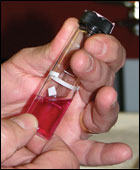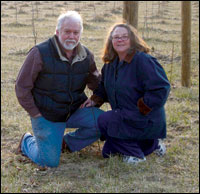|
Sea Grant Extension in Action
Sleuthing a Cover Crop Conundrum
ERICA GOLDMAN
 |
|
With great care, Sea Grant Extension specialist Dan Terlizzi (above left) adjusts the temperature of a water bath. Here he will incubate samples from a nearby farm field to determine how well a cover crop is breaking down nitrate. After an hour-long interval, lab technician Marcia Guedes (above right) adds the last chemical in the protocol. The magenta color in the vial (above) indicates that an enzyme (nitrate reductase) is active in these samples of winter wheat. This means the cover crop is doing its job.
Credit Erica Goldman. |
DRIVING TO WORK on a cool fall morning, Dan Terlizzi pulls to the side of the road, stopping by the edge of a farm field near his house to collect material for the day's experiment. The rural farm field has exactly what he needs — winter wheat - and it's just 45 minutes from his ultra-modern lab at the University of Maryland Biotechnology Institute Center for Marine Biotechnology (COMB) on Baltimore's Inner Harbor.
Terlizzi, a plant physiologist and Maryland Sea Grant Extension Specialist in water quality, is trying to determine how well the plant material he collected on this late fall morning is actively breaking down nitrate. Nitrate is the form of nitrogen that becomes mobile in soil and ultimately enters the water, promoting excessive algal growth. Winter wheat, grown in the Chesapeake watershed, is known for its ability to remove residual nitrate from the soil. But over the past few years, Terlizzi has learned that cover crops may not be removing nitrate as efficiently as previously thought.
Last spring, Terlizzi sampled various cover crops growing in farm fields all over Maryland, looking at soil types that differed from place to place. Using a simple biochemical test, he found that cover crops such as rye and winter wheat were barely breaking down any nitrate at all. Especially in soil high in clay content, he found almost no activity of the enzyme (nitrate reductase) that takes the punch out of nitrogen by converting its highly mobile form nitrate to nitrite. Nitrite is then converted to ammonia, which can be used directly by the plant.
What was stopping these cover crops from breaking down nitrate?
Leaning across the lab bench, Terlizzi checks the temperature of the water bath, a rectangular metal tub insulated in a cocoon of Styrofoam. He puts on his glasses, looking professorial with his silver hair and beard, then peers at a long thermometer submerged in a few inches of water. On the bench opposite him, lab technician Marcia Guedes picks up the narrow leaves of winter wheat that Terlizzi filched from the field and cuts them into 1-cm strips. They fall into a plastic dish resting on a scale. She transfers the leaf cuttings into glass vials and adds several chemicals, carefully placing each one in a test tube rack submerged in the water bath.
The samples will incubate for an hour. If nitrate is actively being reduced, the liquid in the vials will turn a deep magenta color when a final chemical is added after the incubation period.
In the spring samples, Terlizzi believes that excess ammonia in the soil was to blame for blocking the activity of the vital enzyme called nitrogen reductase. He's found that if ammonia is available to the plant, even in small amounts, it will obstruct the breakdown of nitrate — a phenomenon known as "ammonia inhibition." Metabolically, ammonia is a "freebie source of nitrogen for amino acids necessary to the plant," explains Terlizzi.
Ammonia can reach farm fields either from ammonia-based fertilizers or from the atmosphere through precipitation. That plants can metabolize ammonia is not necessarily a bad thing, explains Terlizzi. "It's great if plants absorb ammonia, but if this causes them to stop using nitrate there are a couple of concerns," he says. Ammonia is less mobile in soil than nitrate, he explains, but the very rains that deliver the ammonia and shut down the breakdown of nitrate, cause the nitrate to move through groundwater or surface water — toward the Bay. Also, over time ammonia applied as fertilizer in the soil will convert to nitrate through a bacteria-led process known as nitrification.
In the fall, nitrate levels in the soil should be high. When annual crops like corn and soybeans die at the end of summer, nitrate from fertilizer application remains in large quantities. Are cover crops doing a better job at removing nitrate from the soil at this time of year?
|
Roots of a Career

DAN TERLIZZI'S INTEREST in farms has roots that are both personal and professional. Though primarily focused on algae and marine water quality issues as a Sea Grant Extension specialist, his interest in plant physiology and behavior of more traditional crops goes way back. [more] |
After the vials with plant matter have incubated for an hour at 30°C (86°F), Guedes removes them from the water bath. To each one, she adds a chemical to stop the reaction from progressing any further. Then she adds another chemical that will bind to the product of the reaction, nitrite, making it turn color.
An instant after Guedes adds the final chemical, all of the vials, except the controls, turn bright magenta — a sign that the nitrate reductase enzyme is extremely active.
Guedes then uses a colorimeter to quantify the "purpleness" in each vial. Measuring how much light has been absorbed acts as a proxy for the amount of nitrate reduced. They find that the absorbance readings are off the charts. So much so that the colorimeter reads "out of range" for several of the samples. In these cases, Guedes dilutes the sample with distilled water and takes the reading again.
Terlizzi is surprised, but pleased, by this definitive result. In the four sets of experiments Terlizzi and Guedes conducted last spring, they never saw this bright purple color, indicating that nitrate reduction had been occurring at very low levels, if at all. But in the fall, these cover crops clearly seem to be breaking down nitrate. This is good news for the Bay. These plants seem to be doing their job during the critical time for making sure excess nutrients don't find their way into the waterways.
But the result also raises questions. Terlizzi's not sure why certain crops seem to be so sensitive to ammonia in the spring, but not the fall. As a next step, he plans to take the chemical test out of the lab into the field — a quick farm crop assay of enzyme activity. His ultimate goal as both a researcher and Sea Grant Extension specialist is to translate these results into recommendations that farmers can use — such as what types of cover crops to plant at what time of year in what types of soil. He has some solid clues now as to what makes the nitrate metabolism process tick. But he says he's got a lot more work to do.
|

